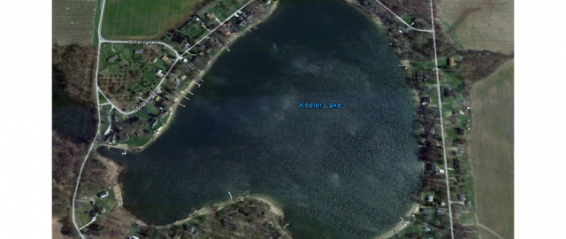40% Curly-Leaf Pondweed Reduction in One Year
85 Acre Keeler Lake, Michigan
First ever Whole Lake System implemented in Michigan. An independent 2012 Study reported significant phosphorous reduction and Eurasian Watermilfoil control – without chemical herbicides!
PROBLEM
- Out-of-control aquatic weeds despite 5 year herbicide program
- Persistent algal blooms despite multiple algaecide treatments per year
- Severe phosphorous overloading from 15’ of decaying organic sediment
SYSTEM RESTORATION DESIGN
- Baseline Water Quality Analysis in July 2011
- Whole-Lake System implemented in August 2011
- Aggressive Biological Acceleration treatment
- 2nd Water Quality Analysis in August 2012 to measure results
RESULTS
- Submersed Curly-leaf Pondweed reduced from 49% (2011) to 1% (2012)
- Eurasian Watermilfoil brought under control
- Significant phosphorous reduction
Keeler Lake Restoration Story
“I have been coming to this lake for over 30 years and can honestly say it has never looked this clear before” Lynn Scardulo, President of the Keeler Lake Property Owners Association
Keeler Lake was suffering from extreme nutrient overloading. There was moderate water transparency, elevated phosphorus levels, abundant exotic and native aquatic weeds, and persistent algal growth.
For 15 years lake property owners had spent approximately $10,000 per year on chemical herbicide treatments to resolve excessive weed and algae growth and poor water quality.
As Keeler Lake Property Assoc. President Lynn Scardulo described it, “this process of (chemical) application was complex not only for the company that we hired but also for the Lake quality chairperson who had to arrange the applications and give reports on its effects and/or lack of results. It was difficult to maintain quality water as the weather conditions became more unpredictable and the increase of new invasive species of weeds and algae occurred.”
“What we were actually doing all this time was putting a bandage on a major problem, without resolving the problem itself” George Hartley, former Keeler Lake Property Association Water Quality Manager.
In 2009 Keeler Lake changed strategy and attacked the cause of eutrophication – nutrient overloading. “We studied and interviewed many companies and their methods of treatment. We contracted with Lake Savers. It definitely was the right thing to do, period. They have the right approach and by far the best technology” George Hartley.
The project began with a detailed water quality analysis of the lake in April & July of 2011 by an independent limnology firm, Restorative Lake Sciences Inc. in accordance with the Michigan Department of Environmental Quality, Water Resources Division.
The 2011 report provided baseline data about water quality parameters such as dissolved oxygen, water temperature, conductivity, chlorophyll a, phytoplankton community composition, pH, total phosphorus, ortho-phosphorus, total suspended solids, and aquatic vegetation communities. These measurements were taken prior to the installation of our system.
After installation in August 2011, a subsequent 2012 analysis was conducted to evaluate the efficacy and/or impacts of Whole Lake Technology to control nuisance algal and aquatic plant growth and reduce excessive organic matter on the lake bottom, along with the overall improvement in lake water quality.
Important to note – this study was the first ever conducted in the State of Michigan that measured the effectiveness of laminar-flow aeration and biological augmentation on a whole-lake scale for the reduction of nuisance organic matter and algae.
As the 2012 report established, all of the baseline water quality indicators that determine overall lake health are going in the right direction. In general, the report states:
“During the 2012 season, unprecedented high water temperatures, low water levels, and high numbers of sunlit days led to excessive submersed aquatic plant growth throughout the state. Despite these conditions, the aeration activity reduced the exotic submersed, Curlyleaf Pondweed from 49% to 1% in 2012 and the Eurasian Watermilfoil only increased from 8% to 12%, which is remarkable given the weather conditions and effects on plant growth.”
As is the case with all eutrophic lakes, reducing phosphorous in the lake was critical. Phosphorous is the nutrient that feeds explosive weed and algae growth and keeps the lake locked in a continuous nutrient overloading cycle. When phosphorous is reduced the lake is brought back into balance…weeds and algae begin to disappear.
According to the 2012 report, after one year there was “significantly less phosphorus present in the water and bioavailable compared to values in 2011. Based on this information, laminar flow aeration with bioaugmentation appears to be reducing nutrients in the lake.”
THE FUTURE
“It has become our pride & joy.” Lynn Scardulo
The future of Keeler Lake is most promising. The 2012 results indicate a positive shift in the trophic index away from eutrophic and toward optimum health. The lake isn’t there yet…but there’s no reason to expect it won’t be soon.
As former Keeler Lake Water Quality Manager George Hartley emphasized “our biologist in a meeting with the Michigan Department of Natural Resources stated that she fully expects at least a 2 foot silt reduction alone each year, thru aeration and treatment, with a natural enzyme bacteria of our lake.”
And not to be taken lightly…“the fishermen have commented on the increase of bigger fish as well (although they don’t like to advertise their favorite place). The weeds are diminishing and the clarity improving” Lynn Scardulo, President of the Keeler Lake Property Owners Association
To download 2012 Keeler Lake Report click (HERE)
























